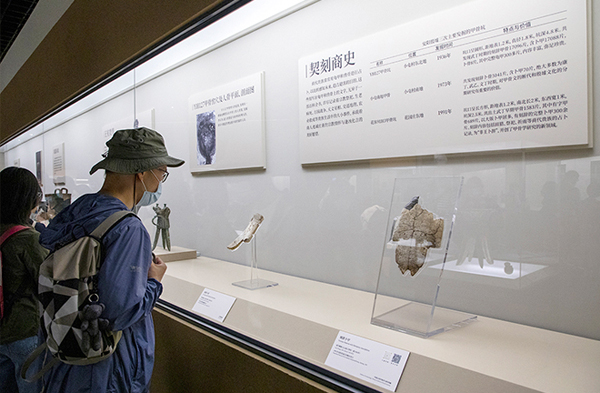Scholars advise on studies of Chinese characters

At the 8th Chinese Characters Development Forum held in Beijing on Aug. 4, scholars conducted in-depth discussions on topics such as deepening the study of Chinese characters, and advancing inter-disciplinary collaboration in the field.
Origin and evolution
The origin of Chinese characters is an age-old issue. Legend goes that Cangjie, an official historian of the Yellow Emperor, invented Chinese characters. In fact, the invention and inheritance of a writing system is not a one-man effort or a one-time effort. Rather, it gets its norm through the hard work of generations of our ancestors.
As one of the symbols of Chinese civilization, ancient Chinese characters were first conceived, matured, and passed down from generation to generation in the Central Plains located in the Yellow River Basin. Dating back 8,000 years ago, the Jiahu carved symbols from Wuyang, Henan Province, may be the earliest prototype of Chinese characters. So far the earliest mature writing system is believed to be constituted by oracle bone inscriptions discovered at the Yinxu Ruins in Henan, which are the source of Chinese characters and the root of fine traditional Chinese culture.
Dating back thousands of years, ancient Chinese characters are carriers of the time-honored Chinese civilization. With historical development, social advancement, and numerous writers’ explorations, the fonts of Chinese characters also evolved continuously, before the simplified Chinese characters that are in use today took shape.
As early as more than 3,000 years ago, both the simplified and traditional versions of the same Chinese characters appeared on mysterious oracle bones. On Han-Dynasty (202 BCE–220 CE) wooden slips excavated in Dunhuang, Gansu Province, dating back more than 2,000 years ago, many simplified characters with the same or similar shape as today can be found. Simplified characters can also be seen everywhere, in famous calligraphy works that have been passed down, and in calligraphy books and inscriptions of different ages. From ancient engraved symbols to oracle bone inscriptions and bronze inscriptions, from seal script to clerical script, and then to regular script, running script, and cursive script, simplification was consistently the general trend in the evolution of Chinese characters.
New research prospects
In recent years, oracle bone studies have gradually risen to prominence in research of Chinese characters. In 2020, in order to comprehensively and systematically carry out research on ancient characters such as oracle bone inscriptions, and reveal the important role of ancient scripts in the development history of Chinese civilization and even human civilization, eight departments in China, including the Publicity Department of the CPC Central Committee, the Ministry of Education, and the State Language Commission, jointly launched the Project on Inheritance and Development of the Ancient Scripts and Chinese Civilization, which have substantially accelerated the development of oracle bone studies.
As a member of the project’s expert committee, Huang Tianshu, a professor from the Research and Conservation Center for Unearthed Texts at Tsinghua University, has recently been thinking about establishing a new branch of oracle bone studies—oracle bone divination studies. In his view, divination is a relatively complex issue, and previous research tends to be fragmented. Such research areas as divination systems, divination organs, divination procedures, divinatory inscriptions on bamboo slips, and characterless oracle bones can all be incorporated into the new branch.
When it comes to using oracle bones for divination purposes, there must have been a development process from carrying no characters to large-scale inscriptions, from being simple divination tools to also vehicles of inscribed characters. Jiang Yubin, a research fellow from the Research Center for Unearthed Documents and Ancient Writings at Fudan University, noted that if we start from reserved and unused areas on oracle bones for inscription, some processing and layout phenomena that have been summarized by scholars can be well explained, and the layout of some important scripts can be reasonably conjectured. Research on characterless oracle bones can even make it possible to predict whether oracle bone inscriptions could appear in the same batch of materials.
Application of technology
The development of science and technology is of great benefit to the study of written language, especially ancient scripts and inscriptions. According to Huang, with the improvement of printing technology, there are now high-definition color photos, six-sided color images, and so on, for documenting oracle bone inscriptions. Color photos can be magnified and observed in the computer, which greatly improves conditions for researching oracle bones, and enables comprehensive collection and truthful presentation of relevant information left by ancients on oracle bones.
Mo Bofeng, a professor from the School of Literature at Capital Normal University, leveraged artificial intelligence technology to compile and test the first nine volumes of theTsinghua Bamboo Slips, a collection of Chinese texts dating to the Warring States Period (475–221 BCE) and written in ink on strips of bamboo. This test has inspired him to, during the compilation process, improve the accuracy rate by connecting fewer characters in a larger context, and to apply knowledge and common sense of related fields to achieve better results.
Further deepening the collaborative research mechanism can contribute more original and major achievements to research on Chinese characters. Wang Lijun, dean of the School of Chinese Language and Literature at Beijing Normal University, suggested strengthening cross-disciplinary collaboration and bringing together expert teams from different disciplines such as philology, archaeology, history, anthropology, biology, chemistry, and computer science, so as to make breakthroughs. In addition, it is essential to look at the issue of Chinese characters from broader academic perspectives, and view pertinent research issues with a consciousness of linking the past and the present, so that academic research can be more applicable in modern times, and truly play its role in cultural construction in the new era.
The forum was co-hosted by the National Museum of Chinese Writing, the Association of Ancient Chinese Characters, the Research and Conservation Center for Unearthed Texts at Tsinghua University, and other institutes.